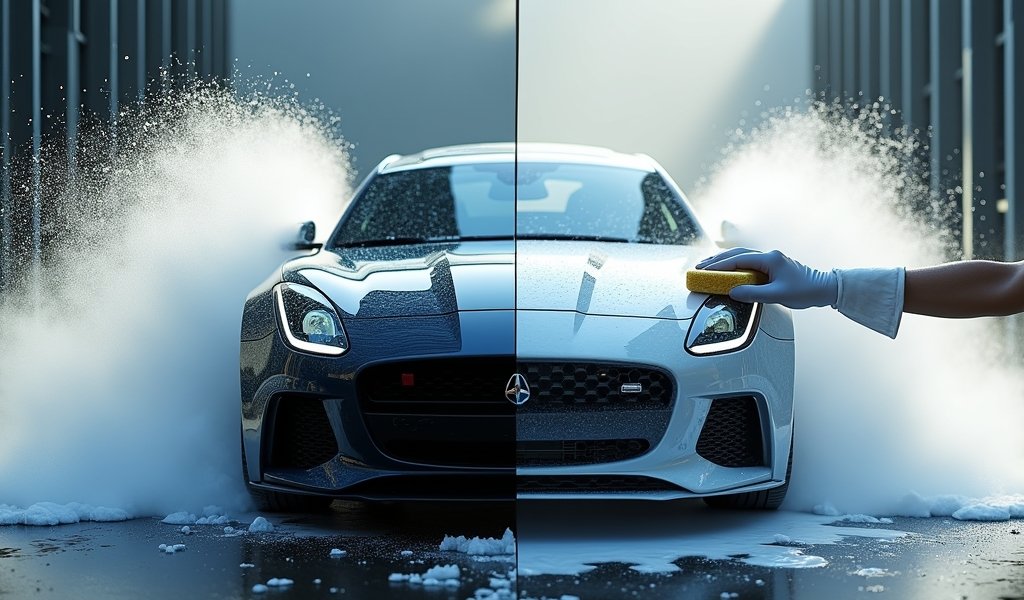Overview
This article presents five expert hacks for car washing that combine the benefits of touchless car washes and hand washing methods, including proper pre-washing, optimizing touchless wash experiences, professional hand washing techniques, adopting a strategic hybrid approach, and applying protective products after cleaning. Rather than choosing one method exclusively, the author recommends a balanced approach tailored to different seasons and conditions, with a maintenance schedule that includes weekly touchless washes, monthly hand washes, and quarterly detailing to maintain a vehicle’s appearance and protect its value.
Table of Contents
- Introduction
- What Sets Them Apart: Touchless vs Hand Washing
- Hack #1: Master the Pre-Wash Ritual
- Hack #2: Supercharge Your Touchless Wash Experience
- Hack #3: Hand Washing Like a Pro
- Hack #4: The Best of Both Worlds – The Hybrid Approach
- Hack #5: Lock In That Shine with Proper Protection
- Conclusion
- Frequently Asked Questions
Introduction
The showdown between touchless car washes and traditional hand washing is like the debate between automatic and manual transmissions – each has die-hard fans, and both have their place in a car owner’s life. After 20 years under the hood and thousands of vehicles detailed, I’ve seen this debate play out countless times in my shop.
Washing your car isn’t just about keeping up appearances – it’s preventative maintenance that preserves your vehicle’s value and finish. Road grime, bird droppings, and environmental contaminants can all wreak havoc on your paint if left untreated, turning what should be a simple wash into an expensive correction job down the road.
In this guide, I’m sharing five game-changing hacks that blend the convenience of touchless systems with the precision of hand washing. These strategies come from years of trial and error and will transform how you approach car care, saving you time, money, and frustration. Let’s dive into the world of touchless car wash vs hand wash and find the perfect formula for your ride.
What Sets Them Apart: Touchless vs Hand Washing
Before we jump into the hacks, let’s clear up what makes each method unique. Touchless car washes use pressurized water and potent cleaning chemicals to dissolve and blast away dirt without physical contact. They’re like power washing for your car – quick, convenient, and accessible 24/7 in many locations. The main appeal? Speed and consistency without the risk of improper washing techniques introducing swirl marks.
Hand washing, on the other hand, is the craftsman’s approach. Using proper tools and techniques, you can control every aspect of the cleaning process. Like a surgeon with a scalpel rather than a shotgun, hand washing allows you to target stubborn areas with precision while being gentler on delicate surfaces and add-ons like wax coatings or ceramic protectants.
Each method shines in different scenarios. Touchless washes excel for regular maintenance cleaning and situations where time is limited. They’re particularly valuable during winter months when salt removal is critical but temperatures make hand washing impractical. Meanwhile, doing your car wash at home by hand delivers superior results for show preparations, addressing specific problem areas, or maintaining vehicles with specialty finishes.

Hack #1: Master the Pre-Wash Ritual
The secret weapon in any car cleaning arsenal isn’t what happens during the main wash – it’s what happens before. Think of pre-washing as clearing the battlefield before sending in your main forces. This crucial step removes the heavy artillery of dirt that could otherwise become ammunition against your paint.
Start with a thorough rinse using moderate pressure water, working systematically from roof to rockers. This initial flood washes away loose surface debris that could otherwise act like sandpaper during the main cleaning phase. For truly filthy vehicles, consider using a foam cannon attachment that blankets your car in thick, clingy suds that begin dissolving contaminants on contact.
Next, target high-impact areas like the front bumper, grille, and lower panels with specialized pre-wash cleaners. These products – often containing surfactants and gentle solvents – loosen stubborn grime like bug splatter, road tar, and tree sap that regular washing struggles to remove. Let the solution dwell for 3-5 minutes (never allowing it to dry completely) before proceeding with your main wash.
For vehicles subjected to extreme conditions (off-road adventures, salted roads, or coastal environments), consider using a citrus-based pre-cleaner that cuts through mineral deposits and road film without stripping protective coatings. This extra step might add five minutes to your routine but can dramatically improve final results regardless of which washing method follows.
Hack #2: Supercharge Your Touchless Wash Experience
Not all touchless car washes are created equal, and knowing how to maximize your experience can mean the difference between disappointing results and a surprisingly effective clean. The first rule: timing is everything. Visit during off-peak hours (typically mid-morning weekdays) when machines are freshly maintained and water recycling systems are less saturated with contaminants from previous washes.
Before entering the wash bay, take a moment to fold in your mirrors and check that windows are fully closed. For vehicles with aftermarket additions like antennas or roof racks, verify compatibility with touchless systems – the high-pressure jets can sometimes dislodge compromised accessories.
When selecting a wash package, prioritize options that include underbody rinsing and pre-soaking treatments rather than cosmetic add-ons like “triple-color foam” that look impressive but add minimal cleaning benefit. The spot-free rinse finale is worth the upgrade, as it helps prevent water spotting that can etch into clear coats over time.
The post-wash inspection is critical. Once through the dryers, pull into a nearby parking spot and quickly survey your vehicle while it’s still slightly damp. Pay special attention to recessed areas around emblems, door handles, and the rear license plate area – common zones where touchless systems struggle. Keep a small detailing kit with quick detailer spray and microfiber towels in your trunk for touching up these missed spots in just minutes.
For maximum effectiveness, integrate touchless washes into a broader maintenance schedule rather than relying on them exclusively. Using them strategically between more thorough hand washings gives you the perfect balance of convenience and care, especially during seasons when your vehicle faces the harshest environmental challenges.
Hack #3: Hand Washing Like a Pro
Hand washing delivers premium results when done correctly, but it’s the technique – not just elbow grease – that makes the difference. The foundation of professional-grade hand washing is the two-bucket method: one bucket with soapy water for cleaning, another with plain water for rinsing your mitt. This simple system prevents you from reintroducing contaminants to clean surfaces, dramatically reducing the risk of swirls and scratches.
Tool selection matters more than you might think. Premium microfiber wash mitts with deep pile construction hold more soapy water while lifting and trapping particles away from paint surfaces. For wheels and intricate areas, designated soft-bristled brushes prevent cross-contamination between your pristine paint and brake dust-covered wheels.
When it comes to soap, forget the dish detergent myths of yesteryear. Modern car wash soaps are pH-balanced formulations that clean effectively without stripping protective waxes or sealants. Look for products with high lubricity that help suspended particles slide off rather than drag across your paint.
The washing motion itself deserves attention – always use straight, overlapping lines rather than circular patterns that can create visible swirl marks under direct sunlight. Work methodically from top to bottom in small sections, rinsing frequently to prevent soap from drying on hot surfaces. This systematic approach ensures you never miss areas while allowing cleaning products to work their magic without baking onto the finish.
For those concerned about water conservation or those in areas with water restrictions, waterless wash products and rinseless wash solutions offer viable alternatives that still deliver hand-wash quality results. These high-tech formulations encapsulate dirt particles and provide enough lubrication to safely wipe away grime with minimal water usage – perfect for quick maintenance washes between more thorough cleanings.

Hack #4: The Best of Both Worlds – The Hybrid Approach
After years in the business, I’ve found that the most effective car care regimen isn’t about choosing sides in the touchless car wash vs hand wash debate – it’s about strategically combining both approaches. This hybrid method plays to the strengths of each technique while mitigating their limitations.
The cornerstone of this strategy is understanding when to deploy each method. During winter months when road salt attacks your undercarriage, weekly touchless washes with underbody rinse features provide crucial protection against corrosion. In spring when pollen counts soar, the precision of hand washing helps remove the sticky yellow dust that automated systems often miss. During summer road trip season, touchless washes at your destination remove travel grime before it bakes onto surfaces in the hot sun.
For an optimized maintenance schedule, consider this pattern:
- Weekly: Quick touchless wash for general cleanliness and salt/contaminant removal
- Monthly: Thorough hand wash with special attention to problem areas
- Quarterly: Complete detail including clay bar treatment and fresh protection
This balanced approach is particularly valuable for daily drivers exposed to varying conditions. By supplementing regular touchless washes with occasional hand cleaning of neglected areas like door jambs, fuel door recesses, and behind bumpers, you’ll maintain professional-level cleanliness without spending every weekend washing your car.
The hybrid approach also makes financial sense. Quality touchless washes typically range from $10-20, while professional hand washes start around $30 and can exceed $50 for premium services. By strategically alternating between methods and handling some simpler hand-washing tasks yourself, you can achieve excellent results while keeping your car care budget reasonable.
Remember that preventing scratches during car washing should always be a top priority regardless of which method you choose. The hybrid approach gives you flexibility to adapt to changing conditions while maintaining consistent protection for your vehicle’s finish.
Hack #5: Lock In That Shine with Proper Protection
The final hack – and possibly the most critical – is understanding that washing alone isn’t enough. The protective layer you apply afterward determines how long your clean car stays clean and shields your paint from environmental damage. Think of it as the difference between cleaning your skin and applying sunscreen – both are necessary for proper care.
After touchless washes, spray-on protection products offer the perfect balance of convenience and effectiveness. Products like spray ceramic coatings or synthetic spray waxes can be applied in minutes, even to a slightly damp vehicle. These formulations create a hydrophobic barrier that causes water to bead and roll off rather than stick and spot, while also making subsequent washing easier as dirt has less ability to bond to protected surfaces.
For hand-washed vehicles where you’ve invested more time in preparation, consider longer-lasting protection options. Traditional carnauba waxes deliver unmatched warmth and depth on darker colors, while synthetic sealants offer extended durability of 4-6 months. For the ultimate in protection, consumer-grade ceramic coatings have made professional-level protection accessible to enthusiasts willing to properly prep their surfaces.
The protection schedule should align with your washing routine:
- After every wash: Quick detailer spray to enhance existing protection
- Monthly: Spray wax or ceramic boost spray
- Quarterly: Full wax or sealant application
- Annually: Consider ceramic coating application or professional paint correction and protection
This layered approach to protection creates defense in depth for your vehicle’s finish. Environmental contaminants must breach multiple barriers before reaching your clear coat, significantly reducing the likelihood of permanent damage. Plus, properly protected vehicles simply look better between washes, maintaining that just-detailed appearance for weeks rather than days.
Conclusion
The touchless car wash vs hand wash debate doesn’t need to end with a single winner. By implementing these five professional hacks – mastering pre-wash techniques, optimizing touchless experiences, perfecting hand washing methods, adopting a hybrid approach, and prioritizing protection – you can enjoy the best of both worlds while keeping your vehicle in showroom condition.
Remember that your specific situation – including your vehicle type, local climate, available time, and personal preferences – should guide your choices. The perfect car care routine is one that you’ll actually maintain consistently, not the one that looks best on paper but proves impractical in real life.
Whether you’re preserving a prized weekend vehicle or maintaining a hard-working daily driver, these strategies will help you achieve professional results without professional prices. Your car represents a significant investment – these techniques help protect that investment while ensuring you always arrive with pride.
Frequently Asked Questions
Is touchless car washing completely safe for my paint?
Touchless car washes are generally safe for properly maintained paint with intact clear coat. However, the strong chemicals used can potentially accelerate wear on already compromised surfaces or strip protection like wax.
How often should I wash my car?
Most vehicles benefit from weekly washing during harsh seasons (winter, pollen season) and bi-weekly washing during milder conditions. Adjust frequency based on your local environment and driving conditions.
Can I damage my car by hand washing incorrectly?
Yes, improper hand washing techniques like using dirty mitts, circular motions, or harsh materials can create swirl marks and scratches. Always use clean, appropriate tools with proper washing motion to prevent damage.
Are automatic car washes with brushes safe to use?
Brush-type automatic washes carry higher risk of introducing swirl marks and minor scratches to your paint. The brushes can trap particles from previous vehicles that may then scrub against your finish.
What’s the most cost-effective way to keep my car clean?
A hybrid approach of occasional DIY hand washing supplemented with basic touchless washes during busy periods offers the best value. This balanced strategy provides good protection while respecting both your time and budget.

